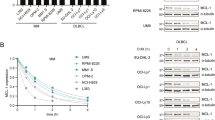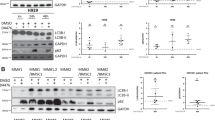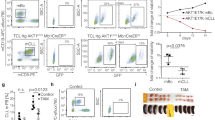Abstract
Multiple myeloma (MM) is a plasma cell malignancy preliminary localized in the bone marrow and characterized by its capacity to disseminate. IL-6 and IGF-1 have been shown to mediate proliferative and anti-apoptotic signals in plasmocytes. However, in primary plasma-cell leukemia (PCL) and in end-stage aggressive extramedullar disease, the cytokine requirement for both effects may be not mandatory. This suggests that constitutive activation of signaling pathways occurs. One of the signaling pathways whose deregulation may play an oncogenic role in MM is the phosphatidylinositol 3-kinase (PI 3-K) pathway. In human growth factor-independent MM cell lines OPM2 and RPMI8226, we show that the PI 3-K inhibitors LY294002 and Wortmannin strongly inhibited cell proliferation, whereas inhibition of the mammalian Target Of Rapamycin (mTOR)/P70-S6-kinase (P70S6K) pathway with rapamycin or of the Mitogen-Activated Protein Kinase (MAPK) pathway with PD98059 had minimal effect on proliferation. In both cell lines, constitutive activation of the PI 3-K/Akt/FKHRL-1, mTOR/P70S6K and MAPK pathways was detected. LY294002 inhibited phosphorylation of Akt, FKHRL-1 and P70S6K but had no effect on ERK1/2 phosphorylation, indicating that the PI 3-K and MAPK pathways are independent. IGF-1 but not IL-6 increased phosphorylation of Akt, FKHRL-1 and P70S6K. Purified plasmocytes from four patients with MM and two patients with primary PCL were studied. In three of them including the two patients with PCL, constitutive phosphorylation of Akt, FKHRL-1 and P70S6K was present, inhibited by LY294002 and enhanced by IGF-1. In these patients with constitutive Akt activation, normal PTEN expression was detected. PI 3-K inhibition induced caspase-dependent apoptosis as confirmed by inhibition with the large spectrum caspase inhibitor Z-VAD-FMK and cleavage of pro-caspase-3. Both cell lines spontaneously expressed Skp2 and cyclin D1 proteins at high levels but no p27Kip1 protein. In the presence of LY294002, cell-cycle arrest in G0/G1 was observed, p27Kip1 protein expression was up-regulated whereas the expression of both Skp2 and cyclin D1 dramatically diminished. PI 3-K-dependent GSK-3α/β constitutive phosphorylation was also detected in OPM2 cells that may contribute to high cyclin D1 expression. Overall, our results suggest that PI 3-K has a major role in the control of proliferation and apoptosis of growth factor-independent MM cell lines. Most of the biological effects of PI 3-K activation in these cell lines may be mediated by the opposite modulation of p27Kip1 and Skp2 protein expression. Moreover, constitutive activation of this pathway is a frequent event in the biology of MM in vivo and may be more frequently observed in PCL.
This is a preview of subscription content, access via your institution
Access options
Subscribe to this journal
Receive 50 print issues and online access
$259.00 per year
only $5.18 per issue
Buy this article
- Purchase on Springer Link
- Instant access to full article PDF
Prices may be subject to local taxes which are calculated during checkout








Similar content being viewed by others
References
Alessi DR, Kozlowski MT, Weng QP, Morrice N, Avruch J . 1998 Curr. Biol. 8: 69–81
Aoki M, Blazek E, Vogt PK . 2001 Proc. Natl. Acad. Sci. USA 98: 136–141
Barata JT, Cardoso AA, Nadler LM, Boussiotis VA . 2001 Blood 98: 1524–1531
Brennan P, Babbage JW, Thomas G, Cantrell D . 1999 Mol. Cell. Biol. 19: 4729–4738
Brunet A, Bonni A, Zigmond MJ, Lin MZ, Juo P, Hu LS, Anderson MJ, Arden KC, Blenis J, Greenberg ME . 1999 Cell 96: 857–868
Cardone MH, Roy N, Stennicke HR, Salvesen GS, Franke TF, Stanbridge E, Frisch S, Reed JC . 1998 Science 282: 1318–1321
Catlett-Falcone R, Landowski TH, Oshiro MM, Turkson J, Levitzki A, Savino R, Ciliberto G, Moscinski L, Fernandez-Luna JL, Nunez G, Dalton WS, Jove R . 1999 Immunity 10: 105–115
Chang HW, Aoki M, Fruman D, Auger KR, Bellacosa A, Tsichlis PN, Cantley LC, Roberts TM, Vogt PK . 1997 Science 276: 1848–1850
Cheng JQ, Ruggeri B, Klein WM, Sonoda G, Altomare DA, Watson DK, Testa JR . 1996 Proc. Natl. Acad. Sci. USA 93: 3636–3641
Datta SR, Brunet A, Greenberg ME . 1999 Genes Dev. 13: 2905–2927
Datta SR, Dudek H, Tao X, Masters S, Fu H, Gotoh Y, Greenberg ME . 1997 Cell 91: 231–241
De Vos J, Jourdan M, Tarte K, Jasmin C, Klein B . 2000 Br. J. Haematol. 109: 823–882
Diehl JA, Cheng M, Roussel MF, Sherr CJ . 1998 Genes Dev. 12: 3499–3511
Dijkers PF, Medema RH, Pals C, Banerji L, Thomas NS, Lam EW, Burgering BM, Raaijmakers JA, Lammers JW, Koenderman L, Coffer PJ . 2000a Mol. Cell. Biol. 20: 9138–9148
Dijkers PF, Medemadagger RH, Lammers JW, Koenderman L, Coffer PJ . 2000b Curr. Biol. 10: 1201–1204
Feng LX, Ravindranath N, Dym M . 2000 J. Biol. Chem. 275: 25572–25576
Ferlin M, Noraz N, Hertogh C, Brochier J, Taylor N, Klein B . 2000 Br. J. Haematol. 111: 626–634
Freund GG, Kulas DT, Mooney RA . 1993 J. Immunol. 151: 1811–1820
Ge NL, Rudikoff S . 2000a Oncogene 19: 4091–4095
Ge NL, Rudikoff S . 2000b Blood 96: 2856–2861
Harada H, Andersen JS, Mann M, Terada N, Korsmeyer SJ . 2001 Proc. Natl. Acad. Sci. USA 98: 9666–9670
Hideshima T, Nakamura N, Chauhan D, Anderson KC . 2001 Oncogene 20: 5991–6000
Hosoi H, Dilling MB, Shikata T, Liu LN, Shu L, Ashmun RA, Germain GS, Abraham RT, Houghton PJ . 1999 Cancer Res. 59: 886–894
Hsu J, Shi Y, Krajewski S, Renner S, Fisher M, Reed JC, Franke TF, Lichtenstein A . 2001 Blood 98: 2853–2855
Hyun T, Yam A, Pece S, Xie X, Zhang J, Miki T, Gutkind JS, Li W . 2000 Blood 96: 3560–3568
Kennedy SG, Kandel ES, Cross TK, Hay N . 1999 Mol. Cell. Biol. 19: 5800–5810
Klein B, Zhang XG, Lu ZY, Bataille R . 1995 Blood 85: 863–872
Lane HA, Fernandez A, Lamb NJ, Thomas G . 1993 Nature 363: 170–172
Latres E, Chiarle R, Schulman BA, Pavletich NP, Pellicer A, Inghirami G, Pagano M . 2001 Proc. Natl. Acad. Sci. USA 98: 2515–2520
Li W, Hyun T, Heller M, Yam A, Flechner L, Pierce JH, Rudikoff S . 2000 Cancer Res. 60: 3909–3915
Mahalingam M, Templeton DJ . 1996 Mol. Cell. Biol. 16: 405–413
Mamillapalli R, Gavrilova N, Mihaylova VT, Tsvetkov LM, Wu H, Zhang H, Sun H . 2001 Curr. Biol. 11: 263–267
Medema RH, Kops GJ, Bos JL, Burgering BM . 2000 Nature 404: 782–788
Morin PJ . 1999 Bioessays 21: 1021–1030
Nakamura N, Ramaswamy S, Vazquez F, Signoretti S, Loda M, Sellers WR . 2000 Mol. Cell. Biol. 20: 8969–8982
Nguyen H, Gitig DM, Koff A . 1999 Mol. Cell. Biol. 19: 1190–1201
Ogata A, Chauhan D, Teoh G, Treon SP, Urashima M, Schlossman RL, Anderson KC . 1997 J. Immunol. 159: 2212–2221
Parada Y, Banerji L, Glassford J, Lea NC, Collado M, Rivas C, Lewis JL, Gordon MY, Thomas NS, Lam EW . 2001 J. Biol. Chem. 276: 23572–23580
Pullen N, Dennis PB, Andjelkovic M, Dufner A, Kozma SC, Hemmings BA, Thomas G . 1998 Science 279: 707–710
Puthier D, Bataille R, Amiot M . 1999 Eur. J. Immunol. 29: 3945–3950
Shayesteh L, Lu Y, Kuo WL, Baldocchi R, Godfrey T, Collins C, Pinkel D, Powell B, Mills GB, Gray JW . 1999 Nat. Genet. 21: 99–102
Shi Y, Frankel A, Radvanyi LG, Penn LZ, Miller RG, Mills GB . 1995 Cancer Res. 55: 1982–1988
Sutterluty H, Chatelain E, Marti A, Wirbelauer C, Senften M, Muller U, Krek W . 1999 Nat. Cell. Biol. 1: 207–214
Takuwa N, Fukui Y, Takuwa Y . 1999 Mol. Cell. Biol. 19: 1346–1358
Tinhofer I, Marschitz I, Henn T, Egle A, Greil R . 2000 Blood 95: 610–618
Toker A, Newton AC . 2000 Cell 103: 185–188
Tsvetkov LM, Yeh KH, Lee SJ, Sun H, Zhang H . 1999 Curr. Biol. 9: 661–664
Tu Y, Gardner A, Lichtenstein A . 2000 Cancer Res. 60: 6763–6770
Acknowledgements
The authors gratefully acknowledge Christine Guillard for helful discussion of the article and Pr Jean Claude Brouet for providing the OMP2 and RPMI8226 cell lines. Supported by grants from the Comité de Paris of the Ligue Nationale contre le Cancer (Associate Laboratory No. 8).
Author information
Authors and Affiliations
Corresponding author
Rights and permissions
About this article
Cite this article
Pene, F., Claessens, YE., Muller, O. et al. Role of the phosphatidylinositol 3-kinase/Akt and mTOR/P70S6-kinase pathways in the proliferation and apoptosis in multiple myeloma. Oncogene 21, 6587–6597 (2002). https://doi.org/10.1038/sj.onc.1205923
Received:
Revised:
Accepted:
Published:
Issue Date:
DOI: https://doi.org/10.1038/sj.onc.1205923
Keywords
This article is cited by
-
Apatinib induces endoplasmic reticulum stress-mediated apoptosis and autophagy and potentiates cell sensitivity to paclitaxel via the IRE-1α–AKT–mTOR pathway in esophageal squamous cell carcinoma
Cell & Bioscience (2021)
-
Fyn kinase regulates dopaminergic neuronal apoptosis in animal and cell models of high glucose (HG) treatment
BMC Molecular and Cell Biology (2021)
-
Diallyl thiosulfinate enhanced the anti-cancer activity of dexamethasone in the side population cells of multiple myeloma by promoting miR-127-3p and deactivating the PI3K/AKT signaling pathway
BMC Cancer (2021)
-
Integrated bioinformatics analysis to decipher molecular mechanism of compound Kushen injection for esophageal cancer by combining WGCNA with network pharmacology
Scientific Reports (2020)
-
BCAP31, a cancer/testis antigen-like protein, can act as a probe for non-small-cell lung cancer metastasis
Scientific Reports (2020)



